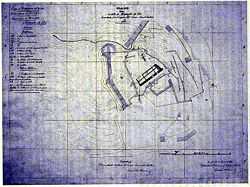Castle of Miranda de Ebro

The Castle of Miranda de Ebro is a medieval fortification located in Miranda de Ebro, Spain.
Location
The castle of Miranda de Ebro is located on the hill of the Picota, in the heart of the old helmet of the city. It is raised to about 500 meters on the level of the sea and offers great views to the city and the mounts that surround it.
History

The origins of the castle of Miranda de Ebro date from 15 October 1358, when Tello of Castile asked the bishopric of Calahorra for the land to construct a castle at the top of the hill of La Picota, place that was occupied by the church of Santa Maria. Nevertheless, the construction sites did not begin until 1449, when Pedro Sarmiento occupied the church. The works were delayed until 1485 and were directed by the expert stonecutter Juan Guas.
The fact that Miranda has been always a border place, has caused that the castle has undergone the consequences of the war in numerous occasions having had to reform it habitually. The last fights that the strength was present at are the War of Independence of Spain and the Carlist Wars, that leave him in ruin situation. Perhaps the most important event of the strength happened during the War of Spanish Independence, when Jose Bonaparte signed the decree of use of the French currency in Spain in the local castle.
In 1903, the city council of the city happens to be the proprietor of the castle and decides to dismantle it. Whereas it leaves from his stones are used for the construction of the bullring (today disappeared), another part of the strength is covered with earth and some take advantage of estructuas for the construction of a water tank.
It has the protection of the generic Declaration of the Decree of 22 of April 1949, and Law 16/1985 on the Spanish Historical Patrimony. At the present time, the castle is in phase of putting in value.[1]
Description
Its plant had trapezial form, with four or five vertices.
Nowadays the North linen cloth is only visible, between Battery of king and Batería of the queen. Also it is conserved, although hidden by the vegetation, the East-West wall and a circular tower in the southwestern angle. It is very probable that he was almenado. The entrance to the fortification was through a barbican: a small defensive system that consisted of a species of recibidor before the front door. Also it had a pit in the side the west that watches towards the rest of the hill of the Picota.
So and as we observed in the rest, the castle was constructed in ashlar masonry stone, at least the external walls, since also have been rest of rubblework.